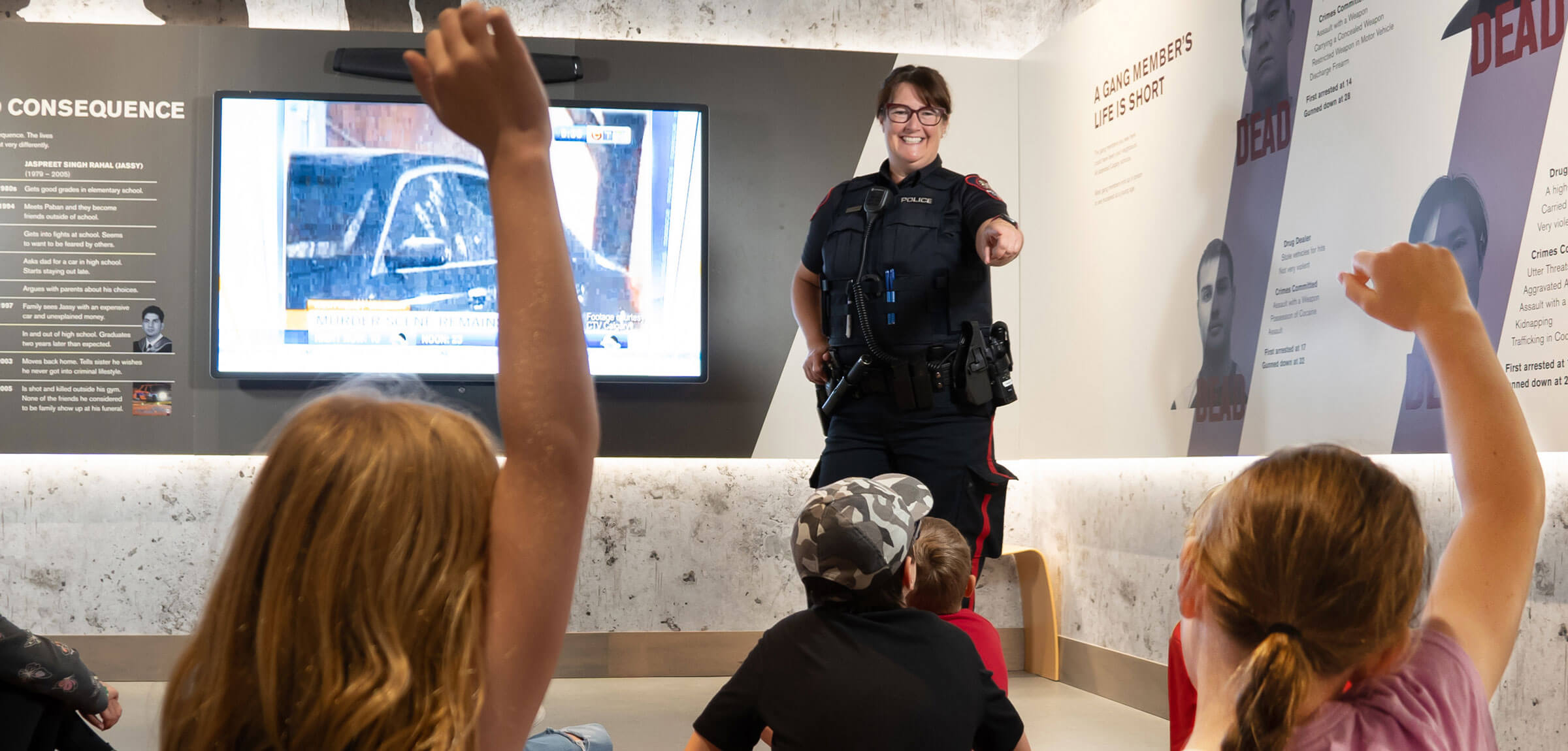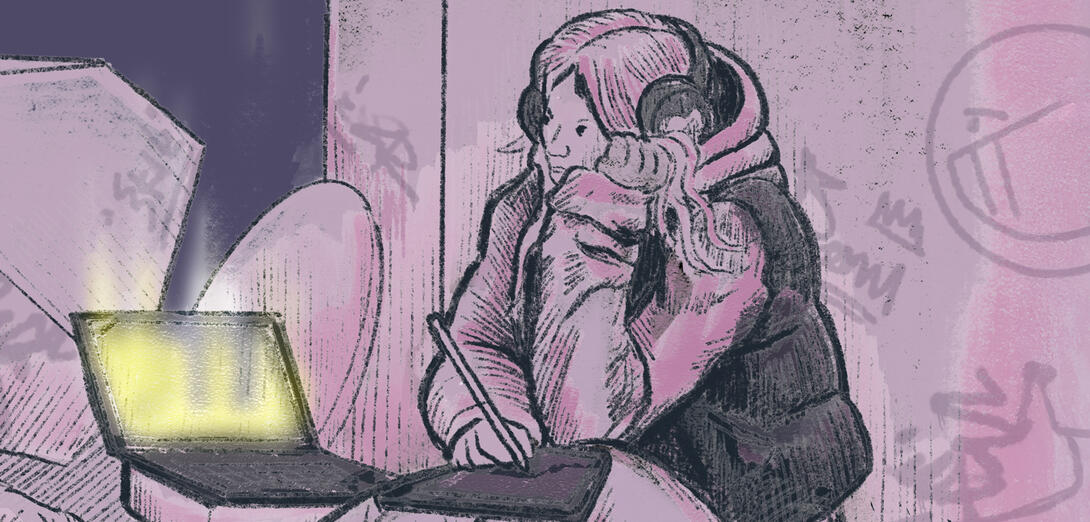Make right choices and pick right people in life, don't take drugs, and have healthy relationships in life.
Student survey respondent
Early intervention and educational crime-prevention programs are recognized as effective forms of prevention for reducing crime (Winterdyk 2013), particularly among individuals with a higher risk (Welsh and Farrington 2012). School-based intervention programs focus on educating youth about crime and its consequences before it occurs, which is preventative rather than reactionary (Clarke 1980). One program that targets school-aged youth is the Calgary Police Interpretive Centre (museum) YouthLink program that focuses on crime prevention by empowering youth to make positive life choices, with an aim of helping youth avoid crime and the risk of being victimized. This crime-prevention program offers a unique, engaging and interactive experience for students and teachers at the museum. This article highlights the findings of a study that was developed through a research partnership between the Werklund School of Education at the University of Calgary and the YouthLink board of directors to explore the impact of the local crime-prevention programming on school-aged youth.
About the research
This study used a mixed-methods approach to explore the impacts of YouthLink’s one-day and week-long crime prevention programming on youth. The research project was guided by the following overarching question: What is the impact of the YouthLink crime prevention and youth education program (e.g., environment, museum space, artefacts)?
Two teachers from the one-day program and one teacher from the week-long program consented to participate in the study. Students in their classes were invited to participate in the study, and 29 students between grades 6 and 8 agreed to participate, with their parents also providing consent. Of these participants, there were 16 students from the one-day program and 13 students from the week-long program.
Two surveys were administered to the participants once they completed their visit to YouthLink. The first survey was administered two days following the visit, and the second survey was administered three months later. The intention of the surveys was to examine students’ and teachers’ immediate and short-term (three-month) recollections of their learning and perspectives about the YouthLink program.
Results: Memorable activities and areas of the museum
In the first survey, 90.63 per cent of students found hearing first-hand stories from a police officer at the museum was helpful, and 84.38 per cent of students found watching real-life video footage helpful for their learning. In the second survey three months later, 100 per cent of students recalled watching the videos as helpful, and 93.75 per cent of students found hearing from a police officer and doing hands-on activities helpful. Overall, in both surveys, the majority of students found activities such as hearing first-hand stories from police officers and watching real-life video footage helped them learn about crime prevention and make safe decisions.
Students also identified the areas at the museum that they found memorable. Students found the areas about gangs and drugs as most memorable. In the first survey, students selected the Gangs area (68.75 per cent), Drugs area (59.38 per cent) and Healthy Relationships (53.13 per cent) area as very memorable. In the second survey, the Drugs (59.26 per cent) and Gangs areas (53.26 per cent) remained in the very memorable category.
Memorable learning
Even after three months, students recalled key messages they had learned when attending the YouthLink program, such as “think about it really hard before you do it” and “stop and think of what this could do to me.” Student participants commented on the importance of thinking and reflecting before taking action and of considering the consequences of their decisions. The following excerpt from one of the students in the open-ended questions in the survey helps illustrate how one student expressed their learning: “Make right choices and pick right people in life, don't take drugs, and have healthy relationships in life.”
In the survey comments, students also reflected what they learned in the Online Safety area and noted how this experience increased their attention to data safety. One of the students shared, “one of the officers [taught] us about how people use Wi-Fi so they can hack into people's cell phones, computers and stuff, so I've been more careful about that stuff.”
The survey respondents also provided written comments to share more detail about their learning in the Gangs and Drugs areas of the museum. The following excerpts are examples of a few of the comments shared by students:
- “When you’re in a gang you’re probably gonna get shot down by other gangs, if u wanna live don't be in a gang.”
- “I learned that most gangs hire young people, then they die early.”
- “I learned about all the bad drugs, and how gangs convince you that you are their friends, and how to be safe.”
Participants discussed how listening to a police officer's investigative stories provided them with knowledge and awareness about these topics that helped them remember what they learned. For example, in the second survey, students reported that stories helped them gain awareness and understand how gangs recruit and how they could protect themselves from unhealthy relationships.
Overall, the survey results showed that students reported a high level of engagement while attending the YouthLink field trip. Teachers also shared in their survey responses how conversations about the museum experience have continued in the classroom even three months after the field trip. Students were particularly engaged by authentic, investigative and interactive learning experiences at the museum. Storytelling by police officers and real video footage were approaches that made the learning experience memorable and helped them learn about making safe decisions.
Discussion
The results from this study revealed pedagogical approaches used in the different areas of the museum that helped students learn by keeping them engaged when visiting YouthLink and supported their recollections of learning after three months. Authentic learning experiences such as storytelling, hearing from police officers, first-hand stories through real video footage, and interactive and investigative activities proved particularly beneficial. The study also found that students retained what they had learned after attending the program. They recalled the messaging or strategies learned, such as thinking before making decisions. Teachers reported that students continued to talk about their experiences and make connections three months after attending the program, indicating some level of retention and continued engagement with the topics. Overall, the results highlight some of the impacts of attending the YouthLink program and how this type of program can contribute to crime prevention and youth education.
Conclusion
The objective of this study was to explore the short-term impacts of the YouthLink crime-prevention program. Students attending YouthLink found authentic experiences at the museum helped them retain what they had learned about making safe decisions. The results from this study hold value for those seeking effective early-intervention and crime-prevention strategies and school-based program approaches. Additional studies would be beneficial to explore the long-term impacts of such programs and to continue developing effective approaches to early crime prevention.
References
Clarke, R. V. G. 1980. “Situational’ Crime Prevention: Theory and Practice.” British Journal of Criminology 20 (2): 136–147.
Welsh, Brandon C., and David P. Farrington. 2012. “Crime Prevention and Public Policy.” In The Oxford Handbook of Crime Prevention, edited by David P. Farrington and Brandon C. Welsh. Oxford University Press: 3–19. https://doi.org/10.1093/oxfordhb/9780195398823.013.0001.
Winterdyk, John. 2013. “Introduction to the Special Issue on Crime Prevention Within the Alberta Context.” International Journal of Child, Youth and Family Studies 4 (1): 1–4. https://doi.org/10.18357/ijcyfs41201311814.
Authors
Adjunct Assistant Professor and Post Doctoral Scholar, Werklund School of Education, University of Calgary
Graduate Research Assistant, University of Calgary
Associate Dean and Associate Professor, School of Education, Ambrose University
Associate Professor and Associate Dean, Werklund School of Education, University of Calgary



